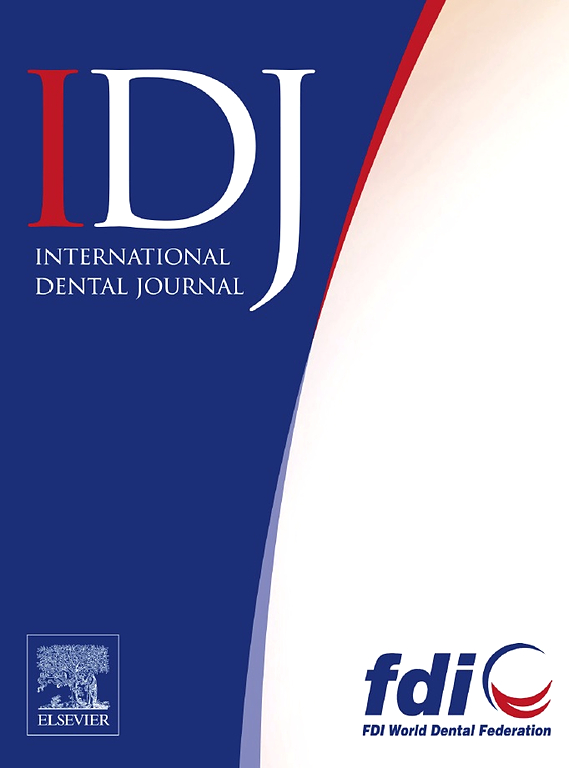口服治疗改善造血干细胞移植患者的预后
IF 3.7
3区 医学
Q1 DENTISTRY, ORAL SURGERY & MEDICINE
引用次数: 0
摘要
引入和目的细菌影响造血干细胞移植(HSCT)血流感染。我们调查了口腔健康管理的效果及其与医疗服务系统的关系。方法将2018年4月至2022年3月从日本急症医院出院的16岁患者分为自体和异体造血干细胞移植组。多变量分析评估了移植前后口服管理对抗生素使用、麻醉注射和死亡率的影响。结果我们纳入了来自298家医院的12248例患者,其中5936例自体和6312例异体造血干细胞移植患者。同种异体造血干细胞移植患者的口服和非口服治疗组在移植后14天内使用抗生素的定义日剂量(DDD)为34.10(标准差[SD] 20.35) vs 36.37(标准差[SD] 21.33);广谱抗生素使用分别为23.87 (SD 15.82)和24.45 (SD 15.76)。移植后30 d内抗生素使用DDD分别为69.13 (SD 40.18) vs 75.16 (SD 43.47)、45.70 (SD 29.63) vs 47.95 (SD 30.48)。在同种异体造血干细胞移植患者中,经相关因素调整后,口服治疗导致移植后14天内抗生素使用DDD降低2.66,30天内降低6.74。移植后30天内使用广谱抗生素显示DDD降低2.79 (P <;. 01)。使用麻醉品导致DDD降低0.34 (P <;.01), DDD降低0.70 (P <;.01)在30天内。在自体造血干细胞移植患者中,口服治疗不影响结果。非相关HSCT的认证标准分为四类(无认证和认证1-3级),每类医院口腔管理执行度提高8.41分。结论为同种异体造血干细胞移植患者提供适宜的口腔环境有助于预防感染、延长寿命和减轻疼痛。临床相关性牙科和医疗团队之间的协调护理对于在HSCT期间提供安全、个性化和高质量的患者结果至关重要。本文章由计算机程序翻译,如有差异,请以英文原文为准。
Oral Management Improves Patient Outcomes in Hematopoietic Stem Cell Transplantation
Introduction and aims
Oral bacteria influence bloodstream infections in hematopoietic stem cell transplantation (HSCT). We investigated the effects of oral health management and its relationship with medical care delivery systems.
Methods
Patients aged >16 years who underwent HSCT, discharged from Japanese acute care hospitals between April 2018 and March 2022, were categorized into autologous and allogeneic HSCT groups. Multivariable analysis assessed the impact of peri-HSCT oral management on antibiotic use, narcotic injections, and mortality rates.
Results
We included 12,248 patients, 5936 autologous and 6312 allogeneic HSCT patients, across 298 hospitals. The defined daily dose (DDD) of antibiotic use within 14 days post-transplantation in the oral and nonoral management groups for allogeneic HSCT patients was 34.10 (standard deviation [SD] 20.35) vs 36.37 (SD 21.33); broad-spectrum antibiotics use was 23.87 (SD 15.82) vs 24.45 (SD 15.76). Within 30 days post-transplantation, the DDD of antibiotic use was 69.13 (SD 40.18) vs 75.16 (SD 43.47) was 45.70 (SD 29.63) vs 47.95 (SD 30.48), respectively. In allogeneic HSCT patients, oral management resulted in lower DDD of antibiotic use by 2.66 within 14 days and 6.74 within 30 days post-transplantation, after adjustment for relevant factors. Broad-spectrum antibiotic use within 30 days post-transplantation showed a lower DDD by 2.79 (P < .01). Narcotic use led to a 0.34 lower DDD (P < .01) within 14 days and 0.70 lower DDD (P < .01) within 30 days. In autologous HSCT patients, oral management did not affect the outcomes. The certification standard for unrelated HSCT, categorized into four classes (no certification and certification levels 1-3), was associated with an 8.41 point increase in hospital oral management implementation per class.
Conclusion
Ensuring an appropriate oral environment for allogeneic HSCT patients helps preventing infection, extending life expectancy, and alleviating pain.
Clinical relevance
Coordinated care between dental and medical teams is essential to deliver safe, personalized, and high-quality patient outcomes during HSCT.
求助全文
通过发布文献求助,成功后即可免费获取论文全文。
去求助
来源期刊

International dental journal
医学-牙科与口腔外科
CiteScore
4.80
自引率
6.10%
发文量
159
审稿时长
63 days
期刊介绍:
The International Dental Journal features peer-reviewed, scientific articles relevant to international oral health issues, as well as practical, informative articles aimed at clinicians.
 求助内容:
求助内容: 应助结果提醒方式:
应助结果提醒方式:


